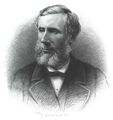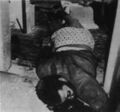Template:Selected anniversaries/December 4: Difference between revisions
No edit summary |
No edit summary |
||
| Line 15: | Line 15: | ||
||1680: Thomas Bartholin dies ... physician, mathematician, and theologian. He is best known for his work in the discovery of the lymphatic system in humans and for his advancements of the theory of refrigeration anesthesia, being the first to describe it scientifically. Pic. | ||1680: Thomas Bartholin dies ... physician, mathematician, and theologian. He is best known for his work in the discovery of the lymphatic system in humans and for his advancements of the theory of refrigeration anesthesia, being the first to describe it scientifically. Pic. | ||
||1750: Henri Jean-Baptiste Grégoire (often referred to as the Abbé Grégoire) born ... was French Catholic priest, Constitutional bishop of Blois and a revolutionary leader. He was an ardent abolitionist of human slavery and supporter of universal suffrage. He was a founding member of the Bureau des longitudes, the Institut de France, and the Conservatoire national des arts et métiers. Pic. | ||1750: Henri Jean-Baptiste Grégoire (often referred to as the Abbé Grégoire) born ... was French Catholic priest, Constitutional bishop of Blois and a revolutionary leader. He was an ardent abolitionist of human slavery and supporter of universal suffrage. He was a founding member of the Bureau des longitudes, the Institut de France, and the Conservatoire national des arts et métiers. Pic. | ||
| Line 39: | Line 37: | ||
||1935: Charles Richet dies ... physiologist, bacteriologist and pathologist who was awarded the 1913 Nobel Prize for Physiology or Medicine. He coined (1902) the term "anaphylaxis" meaning "against protection" to describe the subject of his research, when he found a second vaccinating dose of sea anemone toxin caused a dog's death. Instead of producing protection, as expected in the normal response to vaccination, the first dose had produced a life-threatening sensitivity. This led to an understanding a variety of allergic reactions, hay-fever and asthma. His other interests included aviation: attracted by Marey's experiments on bird flight, Richet participated in the design and construction of one of the first airplanes to leave the ground under its own power. Pic. | ||1935: Charles Richet dies ... physiologist, bacteriologist and pathologist who was awarded the 1913 Nobel Prize for Physiology or Medicine. He coined (1902) the term "anaphylaxis" meaning "against protection" to describe the subject of his research, when he found a second vaccinating dose of sea anemone toxin caused a dog's death. Instead of producing protection, as expected in the normal response to vaccination, the first dose had produced a life-threatening sensitivity. This led to an understanding a variety of allergic reactions, hay-fever and asthma. His other interests included aviation: attracted by Marey's experiments on bird flight, Richet participated in the design and construction of one of the first airplanes to leave the ground under its own power. Pic. | ||
||1945: Thomas Hunt Morgan dies ... evolutionary biologist, geneticist, embryologist, and science author who won the Nobel Prize in Physiology or Medicine in 1933 for discoveries elucidating the role that the chromosome plays in heredity. Pic. | ||1945: Thomas Hunt Morgan dies ... evolutionary biologist, geneticist, embryologist, and science author who won the Nobel Prize in Physiology or Medicine in 1933 for discoveries elucidating the role that the chromosome plays in heredity. Pic. | ||
| Line 56: | Line 52: | ||
||1998: The Unity Module, the second module of the International Space Station, is launched. | ||1998: The Unity Module, the second module of the International Space Station, is launched. | ||
</gallery> | </gallery> | ||
Latest revision as of 16:59, 7 February 2022
1131: Polymath, scholar, mathematician, astronomer, philosopher, and poet Omar Khayyám dies.
1798: Physician and physicist Luigi Galvani dies. In 1780, he discovered that the muscles of dead frogs' legs twitch when struck by an electrical spark.
1820: Physicist John Tyndall dies of accidental chloral hydrate overdose. He studied diamagnetism, and made discoveries in the realms of infrared radiation and the physical properties of air.
1969: Black Panther Party members Fred Hampton and Mark Clark are shot and killed during a raid by 14 Chicago police officers. In January 1970, a coroner's jury will hold an inquest and rule the deaths to be justifiable homicide. Critics will contend that Hampton was assassinated.
1973: The Pioneer 10 space probe makes its closest approach to the planet Jupiter, at a range of about 132,252 kilometers (82,178 mi).




